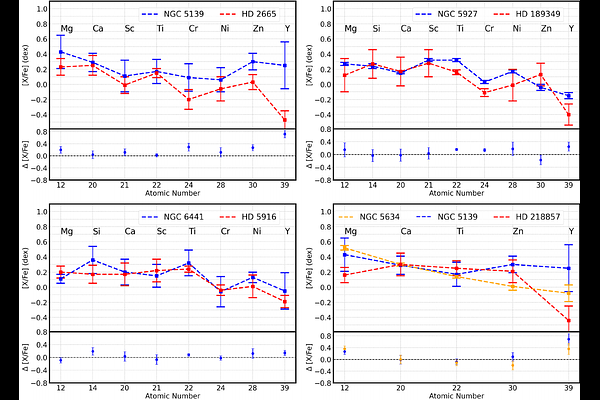Stellar Ancestry Unlocked: Chemical and Orbital Clues Link Metal Poor Stars to Globular Clusters and the Galaxy's Thick Disk

Stellar Ancestry Unlocked: Chemical and Orbital Clues Link Metal Poor Stars to Globular Clusters and the Galaxy's Thick Disk
Gizay Yolalan, Timur Şahin, Selçuk Bilir, Olcay Plevne
AbstractThis study presents a detailed chemical, kinematic, and orbital dynamic analysis of five metal poor stars in the solar neighborhood: HD 2665, HD 5916, HD 122956, HD 189349, and HD 218857. Using high-resolution spectroscopic data from the ELODIE and ESPaDOnS instruments, we derived elemental abundances for 29 species (25 elements: C, O, Na, Mg, Al, Si, S, Ca, Sc, Ti, V, Cr, Mn, Fe, Co, Ni, Cu, Zn, Sr, Y, Zr, Ba, Ce, Nd, and Sm) via LTE based analysis with ATLAS9 model atmospheres. Notably, we report first time detections of Ce and Nd in HD2665; Al, V, Sm, and Mn in HD5916; Al in HD 122956; and C, O, S, Sc, Mn, Co, Cu, Zn, Sr, Zr, Nd, and Sm in HD 189349. Dynamical and chemical diagnostics reveal distinct origins: HD 2665 shows strong orbital and chemical similarity to GC NGC 5139 ($\omega$ Cen), while HD 218857 exhibits chemodynamic signatures consistent with NGC 5634. HD 122956 aligns with NGC 6864 (M75), though intriguingly shares age, metallicity ([Fe/H]), and [Mg/Fe] ratios with NGC 6517, a cluster whose reported abundances are derived solely from one star with APOGEE $H$-band spectroscopic measurements, as no optical spectroscopic data exist for its members. In contrast, HD 5916 and HD 189349 exhibit kinematic and chemical properties consistent with the field-star population and are classified as thick disk members.